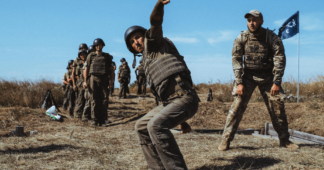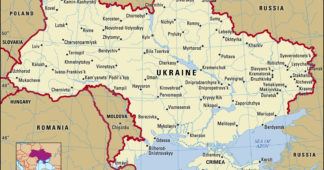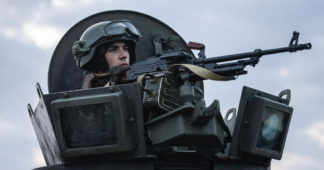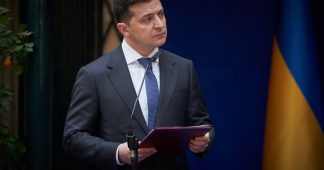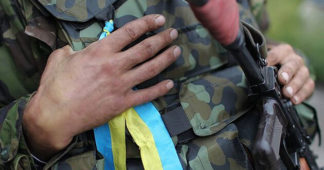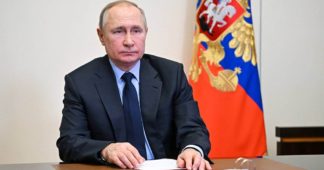By Peter Schwarz
Ukraine is becoming a rallying point for neo-Nazis and mercenaries from all over the world. They are being given the opportunity to fight, kill and gain experience under real war conditions.
The resulting unrestrained banditry is exacerbating and prolonging the war. Moreover, the mobilization of such forces is a danger to the working class in the countries from which the mercenaries originate.
Mussolini’s fascist shock troops, who terrorised Italian workers after the First World War, the German Freikorps, who murdered socialists Rosa Luxemburg and Karl Liebknecht and the bourgeois politicians Walther Rathenau and Matthias Erzberger, and Hitler’s Storm Troopers were recruited from such brutalised front-line fighters.
Ukraine’s role as a place of pilgrimage for militant neo-Nazis did not just begin with the start of the current war. The far-right militias that played a central role in the overthrow of President Yanukovych in 2014 and subsequently kept the war in the Donbas going are very well networked internationally, maintaining relations with militant neo-Nazi groups all over the world.
According to Time magazine in January of last year, “more than 17,000 foreign fighters from 50 countries have come to Ukraine in the last six years,” as the WSWS has reported .
In particular, the Azov Regiment, founded by the self-confessed neo-Nazi and anti-Semite Andriy Biletsky, plays a central role in recruiting and training far-right forces. The regiment was incorporated into the Ukrainian National Guard in the autumn of 2014 and deployed in the fight against the pro-Russian separatists in eastern Ukraine, giving it access to state-of-the-art weaponry provided by the US and other NATO member countries.
Since the beginning of the current war, the recruitment of mercenaries has been official government policy. At the end of February, President Volodymyr Zelensky announced the creation of an “International Legion.” He declared, “If you have combat experience, you can join us and defend Europe with us.”
Since then, the Ukrainian government has been intensively recruiting volunteers, preferably with military training and combat experience, via social media and on special websites. It provides detailed instructions on how to join the “fight against the aggressor,” and refers people to the Ukrainian embassies, which will clarify experience and suitability and help with travel.
An official promotional video makes clear to whom the appeal is aimed. With a mixture of right-wing hero worship and vulgar Russophobia, it appeals to the basest instincts.
The video begins with the words: “This is an open call to all the heroes of the free world.” Then, accompanied by images of battle scenes and heavy war equipment, it says of Russian President Vladimir Putin: “He planned the ‘blitzkrieg’ but got the ‘blitz-fuck’ instead, when his numerous bastards who call themselves the “Russian Army” met Ukrainians armed with Stingers, Javelins, Bayraktars and an uncompromising willingness to protect liberty.”
Although recruitment is now taking place through official government channels, right-wing extremists continue to play a central role. According to research by Die Zeit, whose reporter claimed to be interested in volunteering, “the boundaries between the state’s official International Legion and the far-right volunteer regiment” are seemingly fluid.
For example, according to a recruiter, the Azov headquarters in Kiev is “the official place for gathering and training” not only for the far-right regiment, but also for volunteers seeking to join the Ukrainian military’s International Legion.
Olena Semyanka, the best-known leading figure of the Azov Regiment’s political wing, who has had herself photographed with a Swastika flag, told Die Zeit that she was now an assistant to a deputy of President Zelensky’s ruling party and was supporting him in building up the International Legion.
“A right-wing extremist who also recruits foreign fighters for Ukraine’s official International Legion—can that be true?” asks Die Zeit. Apparently, the answer is yes.
Georgian and Chechen Legion
The Georgian Legion and the Dzhokhar Dudayev Battalion, recruited from veterans of the Georgian and Chechen wars, also serve as a focal point for international legionnaires. Both were formed in 2014 to fight the pro-Russian separatists in eastern Ukraine because the Ukrainian army had largely collapsed following the right-wing coup in Kiev.
Although the new government reinstated conscription, which had been suspended by ousted President Yanukovych, most soldiers were unwilling to fire on their fellow citizens in the breakaway regions. Hundreds of thousands evaded conscription by going into hiding or fleeing to neighbouring countries. The government systematically conducted raids to apprehend them. In February 2016, the Ukrainian Ministry of Defence reported that 26,800 cases of draft evasion had been opened.
Under these circumstances, the vehemently anti-Russian Georgian and Chechen legionnaires, notorious for their brutality, played a decisive role in keeping the war in eastern Ukraine going. The 2015 Minsk Agreement, which provided for a ceasefire and an autonomy arrangement for eastern Ukraine, was signed by the Kiev government merely to buy time.
The Georgian Legion, commanded by former Georgian officer Mamuka Mamulashvili, prides itself on recruiting only battle-hardened professionals. In addition to Georgians, its ranks include numerous mercenaries from Western countries and Ukrainians who volunteered to fight against Russia in Chechnya and Georgia. A report that appeared in the Canadian newspaper Globe and Mail on 13 February paints a picture of the character and ethos of these mercenaries.
Igor Mazur, a “Ukrainian ultranationalist has been fighting in wars around the ex-USSR since he was 18,” the newspaper reports. In 1992, he went to Transnistria, where he joined the ultra-right Ukrainian People’s Self Defence (UNSO). As a UNSO member, he fought against Russia in Abkhazia and in the first Chechen war, and supported the pro-Western regime change operations in Ukraine in 2004 and 2014. He then fought in the ranks of the Ukrainian army against Russian forces in Mariupol. Now, the 48-year-old has joined a reserve unit and is waiting to go to war again.
Cooperation between the Ukrainian government and these ultra-right militias works well because many government members share their far-right views. For example, Andriy Melnyk, the Ukrainian representative in Germany since 2014, through whose embassy the recruitment of legionnaires is now being carried out, is an admirer of Nazi collaborator Stepan Bandera, whose Organisation of Ukrainian Nationalists (OUN) was responsible for the murder of tens of thousands of Jews and Poles.
Melnyk is notorious for his undiplomatic attacks on the German government, which he accuses of providing insufficient political and military support. On Thursday, he told Die Welt that when it came to the survival of the Ukrainian nation, “I don’t give a shit what choice of words I use.” He said the German government’s decision to continue to buy gas and oil from Russia was “a knife in the back of Ukraine,” adding that Chancellor Olaf Scholz lacked determination in the fight for freedom.
Melnyk’s crude behaviour and far-right views did not prevent the members of the Bundestag (German parliament) from hailing him with a standing ovation as he watched from the public gallery their approval of arms deliveries to Ukraine and the biggest German rearmament since Hitler.
NATO support
Most NATO governments are supporting or encouraging their citizens to join the fight in Ukraine, even though this is illegal in many countries.
British Foreign Secretary Liz Truss said people from Britain who wanted to fight in Ukraine had her “absolute” support.
The Latvian parliament unanimously supported allowing its citizens to take part in the war.
The Danish government said it was not illegal for individuals to choose to go to war.
The Canadian government announced that each citizen could decide for himself whether or not to fight in Ukraine.
In a joint statement, the German interior, justice, and foreign ministries stated that German citizens who officially joined the Ukrainian army were not liable to prosecution, as long as they did not violate international law. The German government, the ministries said, did not want to prevent its citizens from going to Ukraine to fight as a matter of principle.
This is despite the fact that recruiting a German citizen for military service in support of a foreign power is punishable by a prison sentence of three months to five years, according to the Criminal Code, and even the mere attempt to recruit for this purpose is punishable.
In the meantime, numerous legionnaires from all over the world have set off for Ukraine. According to Foreign Minister Dmytro Kuleba, 20,0000 volunteers from 52 countries had registered by 6 March. Many have come from Georgia and Belarus, but many are also said to be on their way from the US, Canada and Britain. According to the Ukrainian embassy in Washington D.C., up to 3,000 volunteers in the US have responded to Zelensky’s call.
Numerous reports about volunteers have appeared in the international media, making clear that there are many right-wing extremists among them.
The Frankfurter Allgemeine Zeitung, which inquired among volunteers and in relevant chat groups, reported on March 7:
“Those who expect extremists among the volunteers are not wrong. On Telegram, a man asked how he can fight. His profile picture includes the saying, ‘Loyalty and Honour,’ behind it is the ‘Black Sun,’ a well-known runic sign of the neo-Nazi scene.”
And at another point, the article states: “In the Telegram groups, there is no glossing over what the operation means. Fighters post close-ups of the faces of dead Russians, covered in blood, with their mouths half open.”
BuzzFeedNews writes: “The Western foreigners who have come to Ukraine are a motley crew. There are idealists, adventurers and then there are the extremists who have seen opportunities to link up with far-right paramilitary groups fighting in Ukraine.”
British newspapers report that veterans with Afghanistan and Iraq war experience are heading out. The Mirror reports on a “crack team of SAS veterans” heading to Ukraine, “funded by a country in Europe, still to be named, via a private military company.”
According to the newspaper, “among them there are highly trained snipers and experts in the use of anti-aircraft and anti-tank missiles.” The Times writes: “More than 150 former paratroopers who served in Afghanistan are on their way to fight on the front line with Ukraine against Russia.”
We remind our readers that publication of articles on our site does not mean that we agree with what is written. Our policy is to publish anything which we consider of interest, so as to assist our readers in forming their opinions. Sometimes we even publish articles with which we totally disagree, since we believe it is important for our readers to be informed on as wide a spectrum of views as possible.
